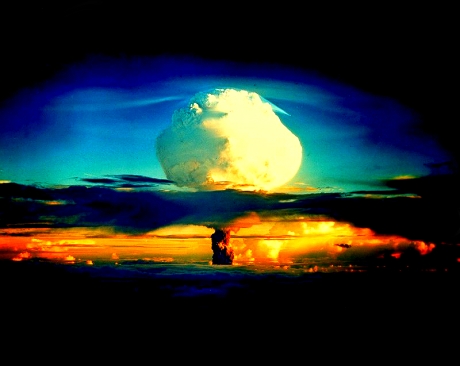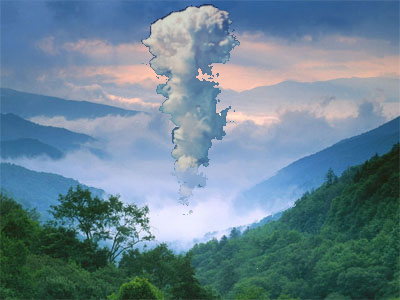A Day of Clouds and Blackness April 23, 2009
Posted by gbcarter in Trinity.Tags: History, Memory, Myth
add a comment
November 1, 1952. Richard Garwin stood on the deck of the Navy destroyer, looking across the ocean between the ship and Enewetak Atoll. The sun lay low on the horizon as Garwin’s team prepared to detonate the world’s first thermonuclear fusion bomb. A device of Garwin’s own design, it would be the largest explosion in human history, harnessing the destructive forces of the sun. As he listened to the countdown blaring through the ship’s PA system, he slipped on the goggles that he desperately hoped he would need. The voice hit zero, and for a split second nothing happened. In the next instant, a brilliant light that surpassed the sun’s radiance blinked soundlessly into existence above the island. A massive fireball rose into the sky, and as the thunderous shockwave reached the ship he saw the top of the inferno begin to spread into the characteristic mushroom shape. Garwin stood on the deck, continuing to watch as the cloud swelled, twenty miles across at the base and a hundred at the cap, twenty-five miles above his head. As he marvelled at the ceiling beneath which he stood, sunlight slanting under the edge, Garwin listened to reports that were filtering in: the island had been completely obliterated, and his mentor Edward Teller had radioed with news that the seismic shocks had been felt around the world. Oppenheimer, his intellectual predecessor, had turned to the Hindu holy book to describe the Trinity test, but Garwin was reminded of a different passage referring to the “splendor of the Mighty One”:
“Before them the earth shakes,
the sky trembles,
the sun and moon are darkened,
and the stars no longer shine.”

Ivy Mike, the First Hydrogen Bomb
The Cold War
The Plot Against America
The Bible
Demon Core April 22, 2009
Posted by gbcarter in Trinity.Tags: History, Memory
add a comment
In 1945 and 1946, two scientists working on experiments to enhance the efficiency of nuclear fuel died as the result of accidental radiation poisoning. In August 1945, Harry Daghlian received a lethal dose of radiation when he accidentally caused a plutonium core that he was working on to go critical; in May 1946, Louis Slotin suffered a similar fate while working on the same plutonium core. The core was nicknamed the “demon core” for its role in the two men’s deaths, and was eventually used for a test detonation to validate their work. The men, who both managed to prevent the reaction from proceeding further at the cost of their own lives, were memorialized in a poem:
“May God receive you, great-souled scientist!
While you were with us, even strangers knew
The breadth and lofty stature of your mind
Twas only in the crucible of death
We saw at last your noble heart revealed.”
Hibukasha April 22, 2009
Posted by gbcarter in Trinity.Tags: History, Memory, Myth, Video
add a comment
Tsutomu Yamaguchi stood in his office, explaining to his boss what had happened to him. “Three days ago, I was in Hiroshima for that meeting you sent me to. I was just getting off the train in downtown when the bomb went off. The thunder ruined my hearing, and the flash would have destroyed my sight if I hadn’t been facing in the other direction. Even though I was shielded by the train, I could see my shadow cast by the brilliant light. The pain of these burns knocked me off my feet. As I laid there, I didn’t know what had happened. This is the Land of the Rising Sun, but in that moment it seemed that the sun had descended into Hiroshima. I count myself lucky to be alive.”
“Incredible,” said the supervisor. “If only we had known, you could have stayed here in Nagasaki and avoided this altogether. As it is, I’m just glad you survived.”
Six miles overhead, Major Charles Sweeney gave the order to his crew.
Smoky April 22, 2009
Posted by gbcarter in Trinity.Tags: History, Memory
add a comment
Bill was laying in a hospital bed in Knoxville with an oxygen tube in his nose and an IV line in his arm. The latest round of radiation was still working its magic on the tumor in his chest, but he didn’t have a clue if it would work or not. The government, paying for his treatment, was probably hoping it didn’t; in spite of the morbidity of the thought he had to laugh a little at the irony of his situation. “What the hell are you laughing about?” That was the new guy in the other bed, who looked to be some white-collar jerk in for a routine checkup; he sounded annoyed that Bill’s existence was interfering with his own. “Nothing you’d understand,” he replied. “What are you doing in this damn hospital?” The other guy, who had said his name was Bert and promptly started ignoring Bill, looked a little put out at the intrusion, but after a second he said, “Just a workup before I start over at Oak Ridge.” “On second thought, I’ll let you in on the joke,” said Bill. “My first posting in the army was to Nevada back in ’57, just in time for an Operation Plumbbob. Ring a bell?”
Bert considered that for a minute, a look of dawning recognition on his face.
“You know, never mind. That’s a story I’d rather not hear.”
Slaughterhouse-Five
The Cold War
March 1, 1954 April 22, 2009
Posted by gbcarter in Trinity.Tags: Image, Memory
add a comment
John stood at his kitchen counter making coffee as the little radio on the table droned away. They didn’t get news very quickly in the Marshall Islands, but there was some available from the military base and from over in the Philippines. John was half-listening to the voice on the radio, which was talking about the new atomic bombs the army had. John had heard about them, knew that they had supposedly ended the war in Japan. He also knew that the Reds had the bomb too; he had even heard they blew a few up in their own country to see what would happen, the barbarians. Tuning out the little radio, he started to go out onto the porch to sit and watch the sun rise—the glow on the horizon was just beginning to show. Light flooded the house, and with a queer suddenness it was a bright morning outside. Bewildered, John walked onto the porch to see a brilliant sunrise in the west.

Pacific Sunrise
Ragtime
Origin Story April 22, 2009
Posted by gbcarter in Trinity.Tags: Doxa, History, Memory, Myth
add a comment
Although Oppenheimer was not personally a religious man, he was very aware of the cultural significance of religion, both in America and in the wider world. He chose the name of the first nuclear test to be “Trinity” because of his identification of his work with the poetry of John Donne, which is loaded with religious and mythic figures. The allusion to the Christian Trinity dovetails with the scientists’ work, which many believed to be unlocking the power of creation. This also tied into the Hindu mythology that Oppenheimer drew heavily upon when describing the event. However, he refused to reduce the concrete reality of the bomb to mythological symbolism. Oppenheimer advocated for scientific responsibility and awareness, something he spoke out about often. He is often reappropriated as a paragon of the anti-militant movement associated with the Cold War arms race, but he himself took issue with this view. In response to one playwright’s depiction of him as a reluctant participant in the Manhattan Project, Oppenheimer responded:
“I had never said that I had regretted participating in a responsible way in the making of the bomb. I said that perhaps he had forgotten Guernica, Coventry, Hamburg, Dresden, Dachau, Warsaw, and Tokyo; but I had not, and that if he found it so difficult to understand, he should write a play about something else.”
Oak Ridge April 22, 2009
Posted by gbcarter in Trinity.Tags: History, Memory
add a comment
My family takes trips to the mountains in East Tennessee: at least every year, sometimes two or three times a year for vacations. On the way, we pass Oak Ridge National Laboratory. Los Alamos and the test sites in the Southwestern desert or the South Pacific are familiar to those who have only had a brief introduction to the Cold War arms race. What is often forgotten in these conventional representations is that the arms race, at least at the beginning, took place not in a wasteland but in the heartland. The men and women who went to work there were not surrounded by desert or ocean but by everyday America. Their work was not a detached theoretical experiment in an isolated environment, but had very real, immediately visible consequences. These people all had unique stories—although they were linked by their work, the experiences and memories and defined them gave them their individuality. That can’t be found in a history book; it’s the sort of thing that comes from diaries and letters, the unique product of the individual rather than the homogenized output of an academic project. That is what must not be lost.
The Cold War
It Can’t Happen Here April 22, 2009
Posted by gbcarter in Trinity.Tags: Image, Memory
add a comment

Smoky Mountain Mushroom Cloud
The Plot Against America
Monument April 20, 2009
Posted by gbcarter in Trinity.Tags: Doxa, Image, Memory, Video
add a comment
Memorials exist for all sorts of things. There are lots of monuments devoted to war and death, and most of them follow a predictable pattern. Everyone is probably familiar with the Vietnam Memorial and its wall of names; those who have seen it recall vividly the impact of seeing 58,195 names of dead soldiers engraved on a single surface. The corresponding event for my generation, the September 11th attack, was memorialized in a powerful way that I remember as particularly affective (rampant commercialization notwithstanding).
But what does a monument tell us about the event it memorializes? Names and numbers are important, but something important is missing. Anyone that knew someone whose name is one of those lists remembers them as a person, a collection of memories and experiences that told a unique story. It can’t be boiled down to a saying on a tombstone or an entry on a census form, and it is crucial to preserve those experiences. For an experience that can’t be boiled down to a singular event, maybe it would be more effective to let those experiences stand on their own, to memorialize them not with a mass of identical entries but with a ready-made figure that can represent individuality for each person who engages with it.